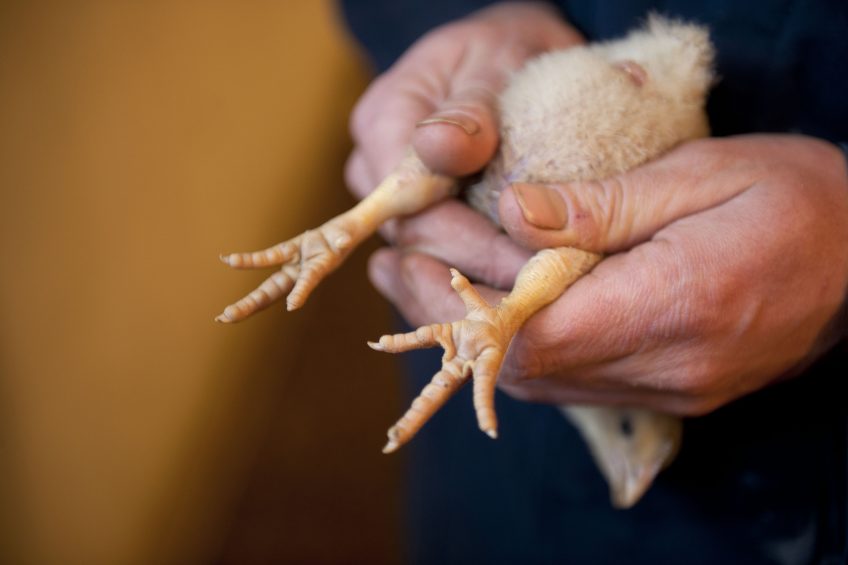Best nutrition for footpad health

Correct concentrations of vitamins and minerals and good management practices are needed, particularly for free-range birds, in order to avoid footpad dermatitis (FPD).
Correct concentrations of vitamins and minerals and good management practices are needed, particularly for free-range birds, in order to avoid footpad dermatitis (FPD).
Research indicates that optimum dietary concentrations of vitamins and minerals are necessary to maximise skin health, and that management practices must be employed to create dry, friable litter in order to minimise contact dermatitis.

First signs of disease often show at the feather cover and skin, skeleton issues. Check out this interactive tool.
Relationship between mositure and FPD
Dr Paul Hocking of the Roslin Institute, Edinburgh, says it is well known that birds kept in deep litter systems are affected by footpad dermatitis and hock burns if the litter contains too much water.
While moisture content was affected by many factors, including humidity, air temperature, stocking rate and gut health, research has shown that adding water to clean wood shavings can be sufficient to induce FPD.
“The prevalence and severity of the disease increased linearly above a certain minimum water content,” he said.
Excess minerals, particularly sodium, and high electrolyte balance have been associated with increasing litter moisture and contact dermatitis.
Hock lesions have a similar aetiology as FPD and have also been associated with high litter ammonia, while breast lesions may be associated with poor breast feathering that exposes the naked skin to the litter and are different from either hock lesions or FPD.
None of the lesions are thought to be caused by bacterial infections.
The integumentary system
Paul McMullan, from Poultry Health Services, explained the importance of the integumentary system in commercial poultry.
“For farmers and veterinarians, the integument can tell us a lot about the health of both the flock as a whole and the individuals which make it up.
“Distribution of moulted feathers in the house, and where dust is accumulating in the house, can provide useful information even before we look at the flock.”
For example, careful assessment of the feathers and skin of birds which have died or been culled may be helpful in selecting representative birds for detailed examinations.
Patterns of skin damage and plumage loss can be a useful guide to bird behaviour as well.
Close inspection of growing feathers can also provide indications of both physiological and systemic infections during the time of feather formation.
He adds the skin can be affected by inflammation associated with viruses with a tropism for skin and generalised viruses such as Marek’s disease, mould infections and external parasites, as well as specific bacterial infections.
Integumentary assessment providing bird welfare
Siobhan Mullan, senior research fellow at the School of Veterinary Science, University of Bristol, looked at how the integument assessment could provide welfare assurance to consumers.
Dr Mullan, who is a scientific adviser for the AssureWel project (www.assurewel.org), said the scheme had developed assessment protocols for laying hens and very recently, broiler chickens.
AssureWel has identified as being important for broilers, to assess at a whole flock level – bird distribution, air quality, panting, dirtiness and general health.
On a 20% sample of birds via a defined walk, AssureWel looks at the following indicators:
- walking ability,
- dirtiness,
- birds requiring culling,
- dead birds,
- litter condition
- behaviour.
She added that non-cage hens in the UK were almost always Soil Association or RSPCA Assured farm assurance schemes. For the last 5 years, all such farms have had a welfare outcome assessment as part of their annual farm assurance inspection.
This includes observations of 50 randomly identified birds for feather loss, using a 3-point scale. The results are shared with the farmer on a benchmarking graph and when results are poor the assessor communicates with them in a way designed to encourage the farmer to make changes to boost welfare.
The prevalence of feather loss in the UK reduced from around a third of birds to just 21% during the first 2 years of the assessment.
“Despite the limitations of assessing the integument of birds within the constraints of the farm assurance system, we have shown that this process enables welfare monitoring and can play a part in improving welfare,” she explained.












